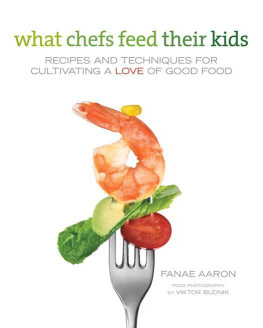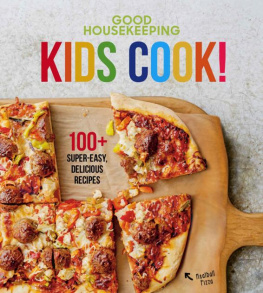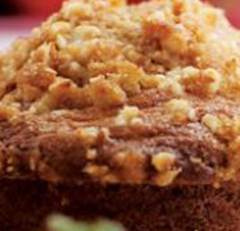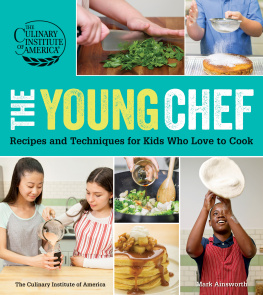



what chefs feed their kids
RECIPES AND TECHNIQUES FOR CULTIVATING
A LOVE OF GOOD FOOD
FANAE AARON
FOOD PHOTOGRAPHY BY VIKTOR BUDNIK

LYONS PRESS
GUILFORD , CONNECTICUT
AN IMPRINT OF GLOBE PEQUOT PRESS
for cody
Copyright 2012 by Fanae Aaron
ALL RIGHTS RESERVED. No part of this book may be reproduced or transmitted in any form by any means, electronic or mechanical, including photocopying and recording, or by any information storage and retrieval system, except as may be expressly permitted in writing from the publisher. Requests for permission should be addressed to Globe Pequot Press, Attn: Rights and Permissions Department, P.O. Box 480, Guilford, CT 06437.
Lyons Press is an imprint of Globe Pequot Press.
Food photography by Viktor Budnik
Text design: Nancy Freeborn
Layout artists: Sue Murray and Melissa Evarts
Project editor: Gregory Hyman
E-ISBN: 978-0-7627-7741-9
Library of Congress Cataloging-in-Publication Data is available on file.
acknowledgments
I want to acknowledge and thank my husband, Flint, for his patience, his kindness, and his love, and my son Cody, who has been a wonder in both our liveshe is also mostly a pleasure to feed. In writing this book I have come to know so many people. I want to thank the community of people who have been so helpfulall the chefs who have participated in the project for sharing not only their personal recipes but their personal stories with me. I know this topic is as important to all of them as it is to me. I want to thank my dedicated foodie friend Kelley King and my friend Piper Bridges-Fila. I also want to thank Leslie Nichols for all of her insight and encouragement. I want to also thank my friend Mary Ann Marino, who jumped in to help on this book when it was only an idea. I cant thank Sue Bell and all the kids at her school, Giggles and Grass Stains, enough for enthusiastically tasting food prepared from the recipes in this book that I would make and bring in for snacks. I want to acknowledge and thank my agent Jenni Ferrari-Adler and the team at Globe Pequot Press, including my editors Mary Norris and Lara Asher, who have been so encouraging, helpful, and supportive.
contents



introduction

When it came time to start feeding my son, Cody, solid foods, like most parents I trooped to the store and stocked up on jars of baby food in a variety of flavors. But then when the time came, I popped open a jar and it just didnt seem that appetizing. Instead, I simply gave Cody some sweet potato that I was eating, then some mashed ripe avocado. I liked that he and I could eat the same thing. Even at the very beginning, we could sit and enjoy a meal together. I knew that what he was eating was good, because I was tasting it myself. But I didnt know where to go from there. I had only rudimentary cooking skills and didnt know what to do to add variety, or even if I should. It was easy to mash some sweet potato with a fork, but I didnt know if I should mix it up and try new things or stick to what Cody liked. I wondered if there was a way to feed kids that both nourishes and stimulates them. Our brains are wired to burst to life with new sensations. They light up and chemicals are released in our brains as we experience the pleasure and delight of something new and interesting. Cody did seem to get very excited about the physical sensation of food in his mouth and a spoon in his hand, and he was very pleased when the two met.
I wondered: Would a child raised by chefs enjoy eating even vegetables, which most kids detest and refuse? What kinds of things do chefs do to introduce their children to eating, and are they able to stimulate curiosity about new foods? Do their kids pick out the smallest speck of parsley and call foods icky and gross, just like other children do?
For chefs, every meal is a new beginningan adventureand that attitude translates to how they feed their kids. I interviewed lots of chefs all around the country for this book and collected their voices and ideas together. This book illustrates their strategies and their attitudes; its not just about cooking for your kids. I now enjoy cooking family meals, but the techniques are the same for eating out. Its about how we can educate kids and eventually enable them, when they are old enough, to make better choices for nourishing themselves.
The recipes in this book are meant to be served as meals for the whole family. Here, the purees are a pared-down part of an overall recipe that the whole family can eat, with suggestions for additions or modifications for older children and adults. Also, the foods in the beginning are more rudimentary and simpler to prepare than the recipes later in the book. Lots of the recipes can be tackled together, with young children doing the measuring and pouring and, later in the book, older children learning about transforming ingredients and the magic of assembling them to make a complete dish together.
The book is organized in chapters by age, recognizing that there are ways that babies and younger children prefer to eat that are different from the kinds of foods that older children gravitate toward. Ive tested all these recipes myself and tried to explain some of the trickier parts of recipes and why they are tricky. Some of the ingredients Id never heard of before tamarind? Is it a paste or a fruit? and it was a bit of an adventure finding them.
When people enter the kitchen, they often drag their childhood in with them, says novelist and food writer Laurie Colwin in her book Home Cooking. I remember reading her books of essays when Cody was an infant, during his naps. When I look back at those days, I realize that those sweet potatoes became the basis for our relationship and how we experience a mealcooking together, sharing food together, eating together. We had fun, we learned a lot, and sometimes we struggled. This early foundation still underlies the way we eat and share a meal. Food writer M. F. K. Fisher summed it up when she said, It seems to me that our three basic needs, for food and security and love, are so mixed and mingled and entwined that we cannot straightly think of one without the others.
infancy


Next page





















